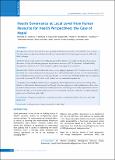Please use this identifier to cite or link to this item:
https://hdl.handle.net/20.500.14356/1846Full metadata record
| DC Field | Value | Language |
|---|---|---|
| dc.contributor.author | Gupta, R | - |
| dc.contributor.author | Devkota, B | - |
| dc.contributor.author | Ghimire, J | - |
| dc.contributor.author | Devkota, A | - |
| dc.date.accessioned | 2023-05-26T06:27:06Z | - |
| dc.date.available | 2023-05-26T06:27:06Z | - |
| dc.date.issued | 2013 | - |
| dc.identifier.citation | Devkota A,G. R. D. B. G. J. (2013). Health Governance at Local Level from Human Resource for Health Perspectives: the Case of Nepal. Journal of Nepal Health Research Council. https://doi.org/10.33314/jnhrc.v0i0.377 | en_US |
| dc.identifier.issn | Print ISSN: 1727-5482; Online ISSN: 1999-6217 | - |
| dc.identifier.uri | http://103.69.126.140:8080/handle/20.500.14356/1846 | - |
| dc.description | Special Issue Articles | en_US |
| dc.description.abstract | Abstract The study aimed to explore the situation of health governance at the local level and suggest measures to address the HRH challenges. Methods: Ninety health facilities from Siraha, Bardiya and Doti districts were included in the study. Focus group discussions (N=36) with different groups and key informants interviews (33 VDC Secretaries, 76 Health Facility Management Committees and 9 central level policy makers and mangers) were conducted. Results: Only 49 (54%) of the health facilities have properly displayed signboard, 42 (47%)citizen charter, 36 (40%) free health services and Information on Aama program in 25 (28%) health facilities. In total 52 (58%) health facilities have not displayed names of women receiving Aama benefits. Seventy two out of 90 health facilities have not displayed social audit reports and 80 (89%) of the health facilities have not maintained complaint box. The initiative of decentralized human resource management, where implemented, has increased ownership at the local level. Staff retention has been reported well though it does not apply in case of the medical doctors. Rule of law in terms of human resource recruitment and transfer, promotion, and training were not fully implemented and were lenient in the upper level. Nepotism and power exercise was frequently reported as a hindrance in implementing the gender and social inclusion policy fully. Conclusions: Transparency, gender and social inclusion is yet to be implemented fully at the district and health facility level. | en_US |
| dc.language.iso | en | en_US |
| dc.publisher | Nepal Health Research Council | en_US |
| dc.relation.ispartofseries | May-Aug, 2013;377 | - |
| dc.title | Health Governance at Local Level from Human Resource for Health Perspectives: the Case of Nepal | en_US |
| dc.type | Journal Article | en_US |
| local.journal.category | Special Issue Articles | - |
| Appears in Collections: | Vol. 11 No. 2 Issue 24 May - Aug, 2013 | |
Files in This Item:
| File | Description | Size | Format | |
|---|---|---|---|---|
| 377-Article Text-401-1-10-20131127.pdf | Fulltext Download | 282.7 kB | Adobe PDF |  View/Open |
Items in DSpace are protected by copyright, with all rights reserved, unless otherwise indicated.
